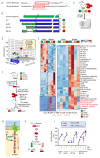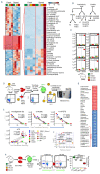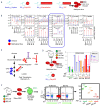The interactome of the N-terminus of band 3 regulates red blood cell metabolism and storage quality
- PMID: 33979990
- PMCID: PMC8561282
- DOI: 10.3324/haematol.2020.278252
The interactome of the N-terminus of band 3 regulates red blood cell metabolism and storage quality
Abstract
Band 3 (anion exchanger 1; AE1) is the most abundant membrane protein in red blood cells, which in turn are the most abundant cells in the human body. A compelling model posits that, at high oxygen saturation, the N-terminal cytosolic domain of AE1 binds to and inhibits glycolytic enzymes, thus diverting metabolic fluxes to the pentose phosphate pathway to generate reducing equivalents. Dysfunction of this mechanism occurs during red blood cell aging or storage under blood bank conditions, suggesting a role for AE1 in the regulation of the quality of stored blood and efficacy of transfusion, a life-saving intervention for millions of recipients worldwide. Here we leveraged two murine models carrying genetic ablations of AE1 to provide mechanistic evidence of the role of this protein in the regulation of erythrocyte metabolism and storage quality. Metabolic observations in mice recapitulated those in a human subject lacking expression of AE11-11 (band 3 Neapolis), while common polymorphisms in the region coding for AE11-56 correlate with increased susceptibility to osmotic hemolysis in healthy blood donors. Through thermal proteome profiling and crosslinking proteomics, we provide a map of the red blood cell interactome, with a focus on AE11-56 and validate recombinant AE1 interactions with glyceraldehyde 3-phosphate dehydrogenase. As a proof-of-principle and to provide further mechanistic evidence of the role of AE1 in the regulation of redox homeo stasis of stored red blood cells, we show that incubation with a cell-penetrating AE11-56 peptide can rescue the metabolic defect in glutathione recycling and boost post-transfusion recovery of stored red blood cells from healthy human donors and genetically ablated mice.
Figures







Comment in
-
Band 3, an essential red blood cell hub of activity.Haematologica. 2021 Nov 1;106(11):2792-2793. doi: 10.3324/haematol.2021.278643. Haematologica. 2021. PMID: 33979993 Free PMC article. No abstract available.
References
-
- Bryk AH, Wisniewski JR. Quantitative analysis of human red blood cell proteome. J Proteome Res. 2017;16(8):2752-2761. - PubMed
MeSH terms
Substances
Grants and funding
LinkOut - more resources
Full Text Sources
Other Literature Sources
Research Materials
Miscellaneous

